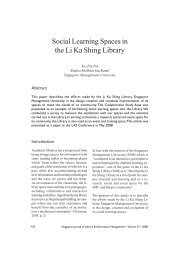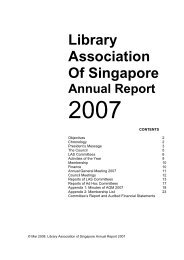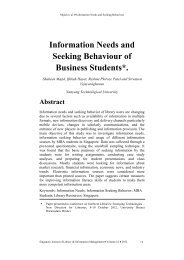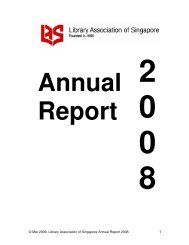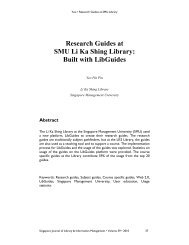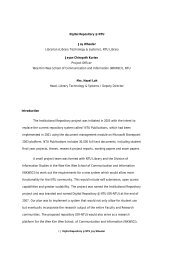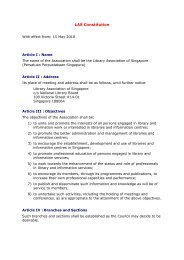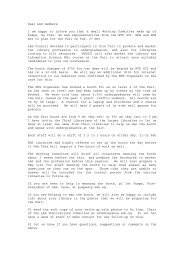The Impact of Technostress on Organisational Commitment among ...
The Impact of Technostress on Organisational Commitment among ...
The Impact of Technostress on Organisational Commitment among ...
Create successful ePaper yourself
Turn your PDF publications into a flip-book with our unique Google optimized e-Paper software.
Ungku Norulkamar • <str<strong>on</strong>g>Impact</str<strong>on</strong>g> <str<strong>on</strong>g>of</str<strong>on</strong>g> <str<strong>on</strong>g>Technostress</str<strong>on</strong>g>Organisati<strong>on</strong>al commitment is typically c<strong>on</strong>ceived as individual’s psychologicalb<strong>on</strong>d to the organisati<strong>on</strong> he is attached to (O'Reilly, 1989). This includes a sense<str<strong>on</strong>g>of</str<strong>on</strong>g> job involvement, loyalty, and belief in the values uphold by the organisati<strong>on</strong>.O’Reilly (1989) cited three stages <str<strong>on</strong>g>of</str<strong>on</strong>g> commitment. <str<strong>on</strong>g>The</str<strong>on</strong>g> first stage, known as thecompliance stage, is the lowest level <str<strong>on</strong>g>of</str<strong>on</strong>g> commitment whereby a pers<strong>on</strong> accepts theinfluence <str<strong>on</strong>g>of</str<strong>on</strong>g> others just because he wants to receive something in return, such aspay. <str<strong>on</strong>g>The</str<strong>on</strong>g> sec<strong>on</strong>d stage is the identificati<strong>on</strong> stage. In this stage, a pers<strong>on</strong> accepts theinfluence <str<strong>on</strong>g>of</str<strong>on</strong>g> others so as to maintain a satisfying relati<strong>on</strong>ship which in turn makeshim feel proud bel<strong>on</strong>ging to a certain organisati<strong>on</strong>. <str<strong>on</strong>g>The</str<strong>on</strong>g> highest level <str<strong>on</strong>g>of</str<strong>on</strong>g>commitment occurs in the last stage, the internalisati<strong>on</strong> stage, in which a pers<strong>on</strong>finds the values <str<strong>on</strong>g>of</str<strong>on</strong>g> the organisati<strong>on</strong> to be c<strong>on</strong>gruent with his pers<strong>on</strong>al values andintrinsically rewarding.According to Meyer and Allen (1991), organisati<strong>on</strong>al commitment is apsychological state which characterises the relati<strong>on</strong>ship <str<strong>on</strong>g>of</str<strong>on</strong>g> the employees to theorganisati<strong>on</strong> and has implicati<strong>on</strong>s <strong>on</strong> the employees’ decisi<strong>on</strong> to remain orc<strong>on</strong>tinue membership in the organisati<strong>on</strong>. <str<strong>on</strong>g>The</str<strong>on</strong>g>y further described three distinctforms <str<strong>on</strong>g>of</str<strong>on</strong>g> commitment which are:• Affective commitment which reflects the strength <str<strong>on</strong>g>of</str<strong>on</strong>g> the employees’ emoti<strong>on</strong>alattachment to, identificati<strong>on</strong> with, and involvement in the organisati<strong>on</strong>• C<strong>on</strong>tinuance commitment which can be described as the employees’ awareness<str<strong>on</strong>g>of</str<strong>on</strong>g> the cost <str<strong>on</strong>g>of</str<strong>on</strong>g> leaving the organisati<strong>on</strong>• Normative commitment which refers to the employees’ feeling <str<strong>on</strong>g>of</str<strong>on</strong>g> obligati<strong>on</strong> toremain in the organisati<strong>on</strong>In terms <str<strong>on</strong>g>of</str<strong>on</strong>g> organisati<strong>on</strong>al commitment am<strong>on</strong>g librarians, McCormick (2000)posited that librarians’ level <str<strong>on</strong>g>of</str<strong>on</strong>g> organisati<strong>on</strong>al commitment is significantlyinfluenced by career stages, type <str<strong>on</strong>g>of</str<strong>on</strong>g> library work setting, and number <str<strong>on</strong>g>of</str<strong>on</strong>g>dependents. Furthermore, more committed and satisfied librarians have beenfound in libraries that support participatory management, open communicati<strong>on</strong>,and opportunities for achievement (Burd, 2003). As far as the Malaysian setting isc<strong>on</strong>cerned, even though Karim and Noor (2006) claimed that Allen and Meyer’sOrganisati<strong>on</strong>al <strong>Commitment</strong> scale was applicable to Malaysian academiclibraries, the study did not discuss the level <str<strong>on</strong>g>of</str<strong>on</strong>g> organisati<strong>on</strong>al commitment <str<strong>on</strong>g>of</str<strong>on</strong>g> theselibrarians.Singapore Journal <str<strong>on</strong>g>of</str<strong>on</strong>g> Library & Informati<strong>on</strong> Management • Volume 38 • 2009 110




